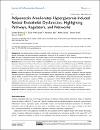Adiponectin Ameliorates Hyperglycemia-Induced Retinal Endothelial Dysfunction, Highlighting Pathways, Regulators, and Networks
| Author | Bushra, Sumbul |
| Author | Al-Sadeq, Duaa W. |
| Author | Bari, Redwana |
| Author | Sahara, Afifah |
| Author | Fadel, Amina |
| Author | Rizk, Nasser |
| Available date | 2022-12-05T07:25:38Z |
| Publication Date | 2022-01-01 |
| Publication Name | Journal of Inflammation Research |
| Identifier | http://dx.doi.org/10.2147/JIR.S358594 |
| Citation | Bushra S, Al-Sadeq DW, Bari R, Sahara A, Fadel A, Rizk N. Adiponectin Ameliorates Hyperglycemia-Induced Retinal Endothelial Dysfunction, Highlighting Pathways, Regulators, and Networks. J Inflamm Res. 2022 May 27;15:3135-3166. doi: 10.2147/JIR.S358594. |
| ISSN | 1178-7031 |
| Abstract | Background: The pathophysiology of diabetic retinopathy (DR) is multifaced. A low level of circulating adiponectin (APN) in type 2 diabetes is associated with microvasculature complications, and its role in the evolution of DR is complex. Aim: This study is designed to explore the potential impact of APN in the pathogenesis of DR, linking the changes in cellular and biological processes with the pathways, networks, and regulators involved in its actions. Methods: Human microvascular retinal endothelial cells (HMRECs) were exposed to 30mM glucose (HG) and treated with globular adiponectin (30μg/mL) for 24 hours. The cells were evaluated for reactive oxidative stress (ROS) and apoptosis. RT-PCR profile arrays were utilized to evaluate the profile of genes involved in endothelial functions, angiogenesis, extracellular matrix, and adhesion molecules for hyperglycemic HMRECs treated with adiponectin. In addition, the barrier function, leukocyte migration, and angiogen-esis were evaluated. The differential expressed genes (DEGs) were outlined, and bioinformatic analysis was applied. Results: Adiponectin suppresses ROS production and apoptosis in HMRECs under HG conditions. Adiponectin improved migration and barrier functions in hyperglycemic cells. The bioinformatic analysis highlighted that the signaling pathways of integrin, HMGB1, and p38 AMPK, are mainly involved in the actions of APN on HMRECs. APN significantly affects molecular functions, including the adhesion of cells, chemotaxis, migration of WBCs, and angiogenesis. STAT3, NFKB, IKBKB, and mir-8 are the top upstream regulators, which affect the expressions of the genes of the data set, while TNF and TGFB1 are the top regulators. Conclusion: Adiponectin significantly counteracts hyperglycemia at various cellular and molecular levels, reducing its impact on the pathophysiological progression towards DR in vitro using HMRECs. Adiponectin ameliorates inflammatory response, oxidative stress, and endothelial barrier dysfunction using a causal network of NFBk complex, TNF, and HMGB1 and integrin pathways. |
| Sponsor | We are grateful to the Biomedical Science Department, College of Health Sciences, and Biomedical Research Center, Qatar University. This study was made possible by a Qatar National Research Fund grant under its Undergraduate Research Experience Program UREP# 17-069-3-018. However, its contents are solely the authors’ responsibility and do not necessarily represent the official views of the Qatar National Research Fund. The data is available under request, and part of this work is presented in the ARVO meeting 2017, published as an abstract in Investigative Ophthalmology & Visual Science, volume 58, issue 8, pages 5225–5225. |
| Language | en |
| Publisher | dovepress |
| Subject | adiponectin bioinformatic analysis diabetic retinopathy human microvascular retinal endothelial cells hyperglycemia |
| Type | Article |
| Pagination | 3135-3166 |
| Volume Number | 15 |
Files in this item
This item appears in the following Collection(s)
-
Biomedical Sciences [652 items ]


